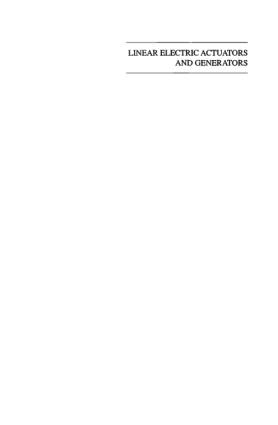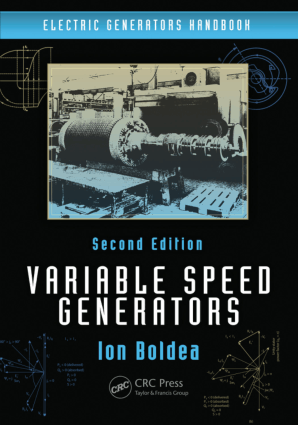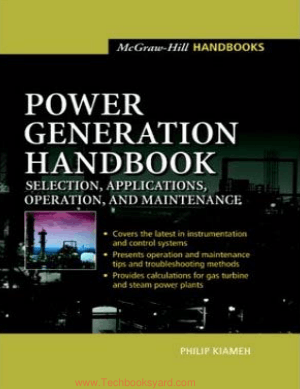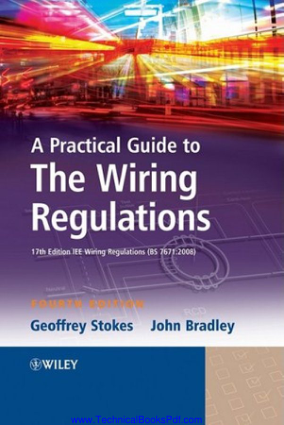CONTENTS
Preface ix
CHAPTER 1
Magnetic Circuits, Fields, and Forces 1
1.1 A Review of Electromagnetic Field Theory 2
1.2 Magnetic Materials 7
1.3 Magnetic Losses 11
1.4 Magnetic Circuits 13
1.5 Ampere’s Law Applied to a Magnetic Circuit 16
1.6 Limitations of the Magnetic Circuit Approach 17
1.7 Energy Relations in a Magnetic Field 19
1.8 Inductance 19
1.9 Magnetic Circuits Containing Permanent Magnets 22
1.10 Forces of Electromagnetic Origin 27
1.11 The Force Equation 28
References 32
VI CONTENTS
CHAPTER 2
Introduction to Linear Electric Actuators and Generators 33
2.1 Terminology 33
2.2 Operation of LEAs 36
2.3 Operation of LEGs 39
2.4 Existing and Potential Applications 40
References 43
CHAPTER 3
Linear Induction Actuators 45
3.1 Performance Specifications 45
3.2 Construction Details for Flat and Tubular Geometries 46
3.3 Field Distributions 54
3.4 Lumped Parameter Representation 58
3.5 Steady-State Characteristics 61
3.6 State-Space Equations 68
3.7 Vector Control Aspects 70
3.8 Design Methodology by Example 75
References 88
CHAPTER 4
Linear Permanent Magnet Synchronous Actuators 91
4.1 Construction Details 91
4.2 Fields in LPMSAs 92
4.3 Sinusoidal Current Model Field Distribution 94
4.4 The dg-Model and Forces 97
4.5 Rectangular Current Mode 102
4.6 Dynamics and Control Aspects 105
4.7 Design Methodology 113
References 132
CHAPTER 5
Linear Reluctance Synchronous Actuators 135
5.1 Practical Configurations and Saliency Coefficients 136
5.2 Field Distributions and Saliency Ratio 141
5.3 Mathematical Model 144
5.4 Steady-State Characteristics 147
5.5 Vector Control Aspects 151
5.6 Design Methodology 152
References 161
Practical Configurations
Instantaneous Thrust
Average Thrust
Converter Rating
State-Space Equations
Control Aspects
Design Methodology
References
CONTENTS Vll
CHAPTER 6
Linear Switched Reluctance Actuators 163
CHAPTER 7
Linear Stepper Actuators 179
7.1 Practical Configurations and Their Operation 180
7.2 Static Forces 183
7.3 Lumped Parameter Models 184
7.4 Control Aspects 188
7.5 LSA Design Guidelines 193
References 199
CHAPTER 8
Linear Electric Generators 201
8.1 Principle of Operation and Basic Configurations 201
8.2 Moving Magnet Linear Alternators 203
8.3 Moving Iron Linear Alternators 210
8.4 Stability Considerations 223
8.5 Choice of Tuning Capacitor 232
References 233
Index 235
PREFACE
Linear electric actuators are electromagnetic devices capable of producing directly
(without any linkages, etc.) progressive unidirectional or oscillatory short-stroke
motion. The motion occurs because of the electromagnetic force developed in the
actuator. Linear electric generators are also linear motion electromagnetic devices
which transform short-stroke oscillatory motion mechanical energy into single-phase
ac electrical energy. Just as a rotary electric machine may operate either as a motor
or as a generator, a linear motion electromagnetic device may be designed to work
either as an actuator or as a generator. From this standpoint, linear electric actuators
and generators are the counterparts of a corresponding rotary electric machine. In
general, however, linear electric machines have been associated with long linear
progressive motion, such as in transportation and similar applications.
Whereas primitive linear electric machines have been in existence for a long
time, since the 1960s there has been a great deal of interest in linear machines for
various applications—especially transportation. Several books and numerous papers
have been published on the subject in the recent past. However, the literature on linear
electric actuators and generators is relatively sparse. Clearly, the potential applications
of these devices are too numerous to mention here. Judged from the present trend, it
would suffice to say that the field of linear actuators and generators may lead to an
industry of “linear motion control” with a large worldwide market.
Much of the existing literature on the subject of linear actuators and generators
deals with the principles of operation and performance calculations. Not much has
been published on their control and detailed design methodologies. In this book, we
present a unified treatment combining topologies of these devices with pertinent field
distributions obtained by the finite-element method, state-space equations governing
their dynamics and control, and detailed design methodologies. The book contains
much new and original material developed by the authors.
In Chapter 1, we briefly review magnetic circuits, fields, and forces. In Chapter
2, we present an overview of linear electric actuators and generators (LEAGs). Basic
definitions, terminology, and operating principles of LEAGs are introduced in this
chapter. A classification of these devices is also presented in Chapter 2. Linear
induction actuators are discussed in Chapter 3. Chapters 4 and 5, respectively, present
linear permanent magnet and linear reluctance synchronous actuators. Linear switched
reluctance actuators are described in Chapter 6, linear stepper actuators in Chapter 7,
and linear electric generators (also termed linear alternators) in Chapter 8. We have
not included “solenoids” here, as they are widely discussed in the literature.
Throughout the book we have attempted to give a unified presentation, namely, basic
construction and topology, field distribution, lumped parameter equivalent circuit, statespace
equations, dynamics and control, followed by design examples.






